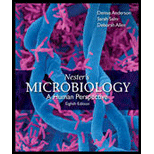
Concept explainers
Describe a detrimental and a beneficial effect of biofilms.
To review:
Description of a detrimental and a beneficial effect of biofilms
Introduction:
The microorganisms in nature can live permanently or temporarily in a hydrousenvironment but most attach themselves to surfaces and live in polymer encased communities called as biofilms. Biofilms causethe sticky substance that coats the drains of the kitchen, the sticky colorless deposit, which grows on surfaces within the mouth.
Explanation of Solution
The formation of biofilms begins when free-floating cellsmove to a surface and attach. Multiplication will then take place and will release hydrophilic polymers, DNA, and polysaccharides. The unrelated cells may attach and grow. The assembly of these polymersisreferred to as extracellular polymeric substances (EPS). EPS gives a biofilm its slimy appearance.
Biofilms have harmful effects. Biofilms can be formed anywhere especially on moist surfaces because it provides the good ground for the bacteria to grow. They tend to be resistant to antibiotics. Biofilms are seen growing around the surfaces of toilets, sinks, in hospitals, wound dressing. Complication of cystic fibrosis, in which the lungs and digestive systems get clogged with mucus, ear infection, heart diseases, and respiratory problems, isthe harmful effectof biofilms. These infections often require a high dose of antibiotics to get rid of the body and it requires a long time.
Biofilms have beneficial effects. They are important for wastewater treatment facilities. The various microbial activity in the water is controlled in the biological treatment of wastewater. This is the filtration process where the wastewater is treated. The conversion of organic carbon in the water into bacterial biomass is the biological filtration. This process makes the treated water more biologically stable and free of all disinfectant. Biofilms are used in the process of bioremediation of contaminated soil. Bioremediation is the process where the toxic organic material is converted into a harmless product. Various toxic contaminants(gasoline, fuel oil) are released accidentally underground in the soil. The bacterial population present in the native soil will use the organic contaminants as a food source. Thus they will make the soil free from all the toxic organic contaminants and will convert them into harmless by-products.
Thus, the harmful effect of biofilm is seen in various health-related problems, such as respiratory disease, ear infection, and a complication of cystic fibrosis. The beneficial effect is seen in the treatment of urban wastewater, bioremediation of contaminated soil.
Want to see more full solutions like this?
Chapter 4 Solutions
Nester's Microbiology: A Human Perspective
- In one paragraph show how atoms and they're structure are related to the structure of dna and proteins. Talk about what atoms are. what they're made of, why chemical bonding is important to DNA?arrow_forwardWhat are the structure and properties of atoms and chemical bonds (especially how they relate to DNA and proteins).arrow_forwardThe Sentinel Cell: Nature’s Answer to Cancer?arrow_forward
- Molecular Biology Question You are working to characterize a novel protein in mice. Analysis shows that high levels of the primary transcript that codes for this protein are found in tissue from the brain, muscle, liver, and pancreas. However, an antibody that recognizes the C-terminal portion of the protein indicates that the protein is present in brain, muscle, and liver, but not in the pancreas. What is the most likely explanation for this result?arrow_forwardMolecular Biology Explain/discuss how “slow stop” and “quick/fast stop” mutants wereused to identify different protein involved in DNA replication in E. coli.arrow_forwardMolecular Biology Question A gene that codes for a protein was removed from a eukaryotic cell and inserted into a prokaryotic cell. Although the gene was successfully transcribed and translated, it produced a different protein than it produced in the eukaryotic cell. What is the most likely explanation?arrow_forward
- Molecular Biology LIST three characteristics of origins of replicationarrow_forwardMolecular Biology Question Please help. Thank you For E coli DNA polymerase III, give the structure and function of the b-clamp sub-complex. Describe how the structure of this sub-complex is important for it’s function.arrow_forwardMolecular Biology LIST three characteristics of DNA Polymerasesarrow_forward
 Comprehensive Medical Assisting: Administrative a...NursingISBN:9781305964792Author:Wilburta Q. Lindh, Carol D. Tamparo, Barbara M. Dahl, Julie Morris, Cindy CorreaPublisher:Cengage LearningEssentials Health Info Management Principles/Prac...Health & NutritionISBN:9780357191651Author:BowiePublisher:Cengage
Comprehensive Medical Assisting: Administrative a...NursingISBN:9781305964792Author:Wilburta Q. Lindh, Carol D. Tamparo, Barbara M. Dahl, Julie Morris, Cindy CorreaPublisher:Cengage LearningEssentials Health Info Management Principles/Prac...Health & NutritionISBN:9780357191651Author:BowiePublisher:Cengage Biology: The Dynamic Science (MindTap Course List)BiologyISBN:9781305389892Author:Peter J. Russell, Paul E. Hertz, Beverly McMillanPublisher:Cengage LearningBasic Clinical Lab Competencies for Respiratory C...NursingISBN:9781285244662Author:WhitePublisher:Cengage
Biology: The Dynamic Science (MindTap Course List)BiologyISBN:9781305389892Author:Peter J. Russell, Paul E. Hertz, Beverly McMillanPublisher:Cengage LearningBasic Clinical Lab Competencies for Respiratory C...NursingISBN:9781285244662Author:WhitePublisher:Cengage





